Monuments and the Haunting Past: Interview with Rostislav Švácha
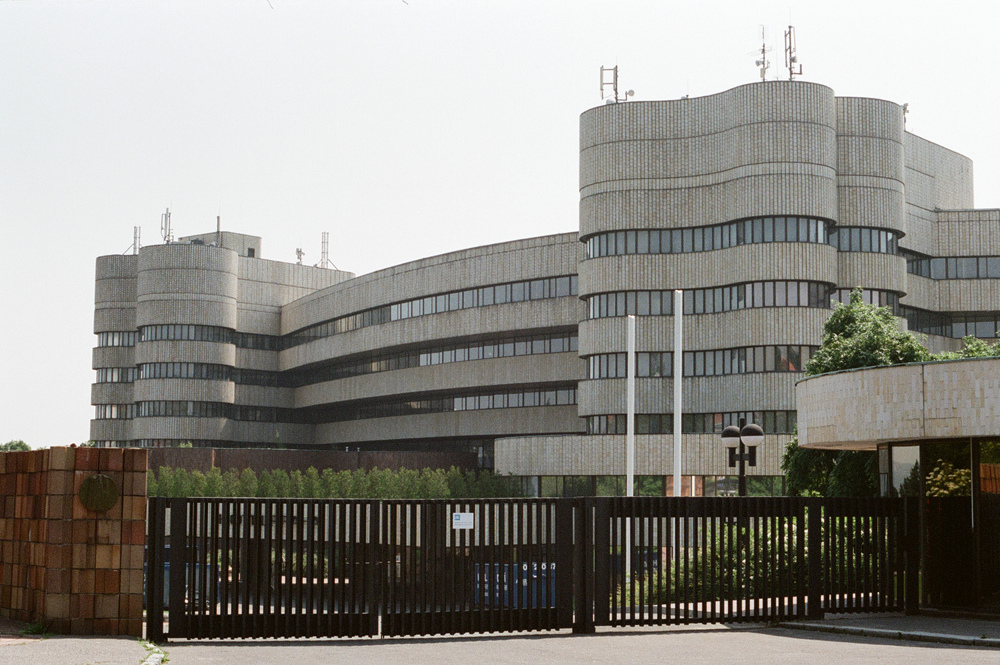 Rostislav Švácha is an architecture critic and historian based in Prague. In this interview, Švácha discusses possible approaches to monuments from the Communist era and the constant re-emergence of the past in the Czech Republic.
Rostislav Švácha is an architecture critic and historian based in Prague. In this interview, Švácha discusses possible approaches to monuments from the Communist era and the constant re-emergence of the past in the Czech Republic.
Jana Beránková: You have extensively analyzed the work of the prominent Czechoslovak architecture critic Karel Teige and his polemics on monumentality with Le Corbusier. How does one recognize a monument?
Rostislav Švácha: I have discussed this issue at recent lectures on Louis Kahn, an architect who challenged traditional metaphors of monumentality. I tried to persuade my students that monumentality needs some intelligible metaphors guaranteeing its effect. For instance, the architecture of public buildings in the nineteenth century has created a generally legible metaphor by imitating antique temples. Museums used antique porticos and domes since the late Empire style. These metaphors have been usually linked to stone. The overuse of stone was later criticized by Karel Teige, who already considered this material to be interconnected with monumentality. In the beginning of the twentieth century, Peter Behrens broadened this discussion by saying that even a small thing can be monumental. He probably meant that if we model a small statue in large volumes, the statue will appear monumental. However, I still have not come to terms with Behrens’ opinion.
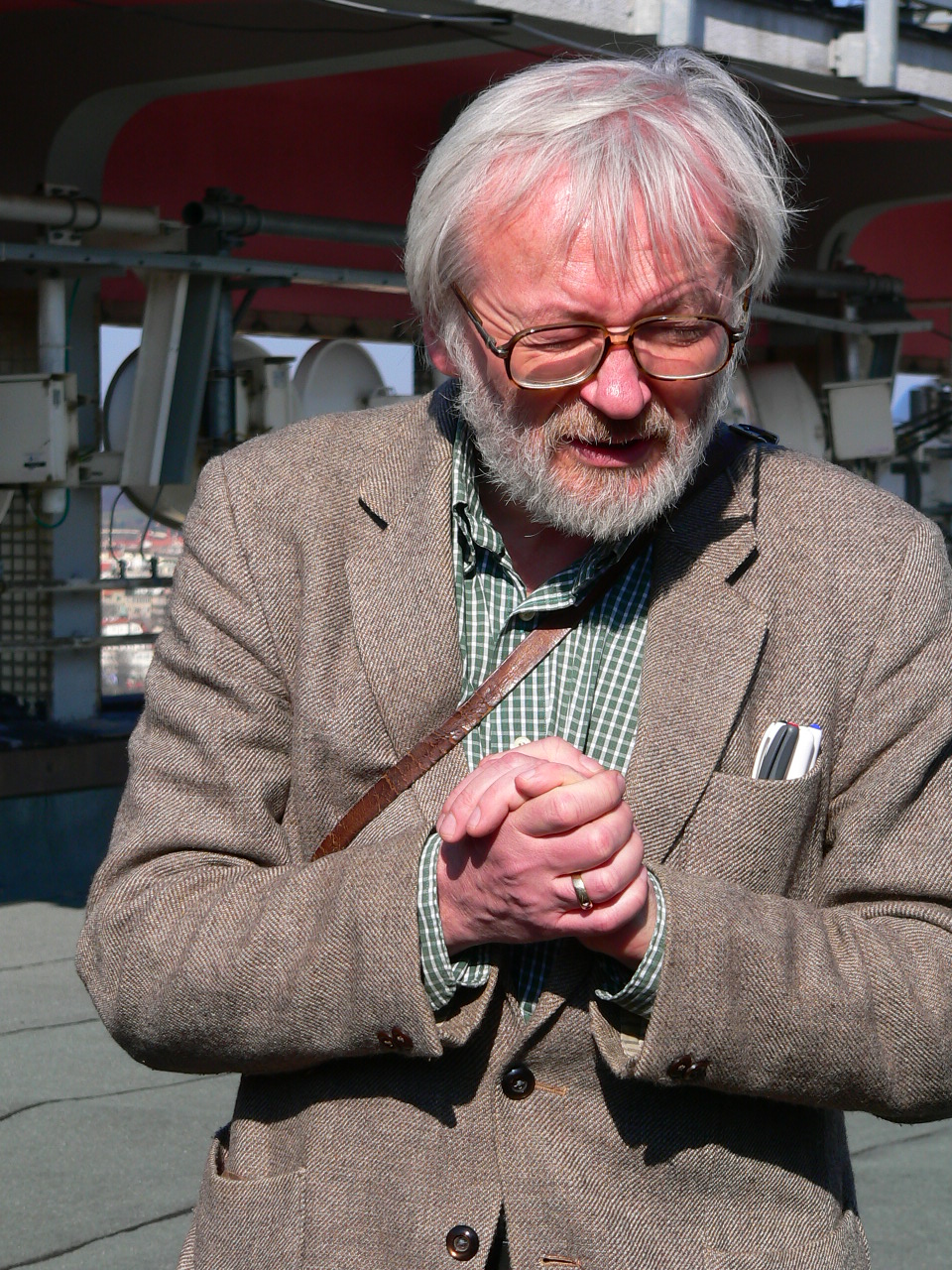 Rostislav Švácha is an architecture critic and historian based at the Academy of Sciences in Prague. He teaches in the Art History and Theory Department of the Academy of Fine Arts in Prague and the Faculty of Arts of the Palacky University in Olomouc. He has edited and contributed to publications such as Sial. Liberec Association of Engineers and Architects, 1958-1990: Czech Architecture Against the Stream; Czech Architecture and Its Austerity: Fifty Buildings 1989-2004; The Prism, the Pyramid and the Arc: Czech Cubist Architecture, 1911-1923; The Architecture of New Prague, 1895-1945. He co-edited the anthology Karel Teige, 1900-1951: L´Enfant Terrible of the Czech Modernist Avant-Garde with Eric Dluhosch. His main research interests include Czechoslovak modern and contemporary architecture. In this interview, Švácha discusses possible approaches to monuments from the Communist era and the constant re-emergence of the past in the Czech Republic.
Rostislav Švácha is an architecture critic and historian based at the Academy of Sciences in Prague. He teaches in the Art History and Theory Department of the Academy of Fine Arts in Prague and the Faculty of Arts of the Palacky University in Olomouc. He has edited and contributed to publications such as Sial. Liberec Association of Engineers and Architects, 1958-1990: Czech Architecture Against the Stream; Czech Architecture and Its Austerity: Fifty Buildings 1989-2004; The Prism, the Pyramid and the Arc: Czech Cubist Architecture, 1911-1923; The Architecture of New Prague, 1895-1945. He co-edited the anthology Karel Teige, 1900-1951: L´Enfant Terrible of the Czech Modernist Avant-Garde with Eric Dluhosch. His main research interests include Czechoslovak modern and contemporary architecture. In this interview, Švácha discusses possible approaches to monuments from the Communist era and the constant re-emergence of the past in the Czech Republic.
Jana Beránková: You have extensively analyzed the work of the prominent Czechoslovak architecture critic Karel Teige and his polemics on monumentality with Le Corbusier. How does one recognize a monument?
Rostislav Švácha: I have discussed this issue at recent lectures on Louis Kahn, an architect who challenged traditional metaphors of monumentality. I tried to persuade my students that monumentality needs some intelligible metaphors guaranteeing its effect. For instance, the architecture of public buildings in the nineteenth century has created a generally legible metaphor by imitating antique temples. Museums used antique porticos and domes since the late Empire style. These metaphors have been usually linked to stone. The overuse of stone was later criticized by Karel Teige, who already considered this material to be interconnected with monumentality. In the beginning of the twentieth century, Peter Behrens broadened this discussion by saying that even a small thing can be monumental. He probably meant that if we model a small statue in large volumes, the statue will appear monumental. However, I still have not come to terms with Behrens’ opinion.
In the polemic on monumentality, Teige reproached Le Corbusier that the Mundaneum looked like ancient pyramids from Egypt or Mexico; he was disturbed by the fact that Le Corbusier chose the pyramid as the chief metaphor for monumentality. A year earlier, Le Corbusier used plastic arts in the competition for the United Nations Headquarters: a statue of prancing horses and a porticolike structure. This must have irritated Teige, who rejected the artistic status of architecture. If one takes architecture for a scientific field and doesn’t believe in neither its artistic substance nor in monumentality, one must logically consider all these components as something absurd.
JB: This relates to Teige’s anthropocentrism – architecture was supposed to serve human subjects and not vice versa. He saw monuments as being unethical because they subjugate the subject to some other force.
RS: Yes, but Teige’s thinking on monumentality evolved in time. In the early 1920s, he only criticized the uneconomical aspect of monumentality; it consumed too much brickwork and stone cladding. Only in the 1930s, he developed a substantial critique, in which he claimed that monumentality serves as an instrument to oppress people. Monumentality was a tool of the ruling class for the subjugation of enslaved masses.
JB: What is your current view on monumentality? Is contemporary architecture inclined to construct monuments?
RS: In the 1930s, many modern architects realized that monumentality is sometimes necessary in order to express festive feelings. Austere functionalism cannot achieve this. Although Czech architects, including Teige, realized that totalitarian regimes had a certain predilection for monumentality, some of them believed that even democracy has to create instruments of monumentality in order to defend itself.
JB: And what could be such a democratic monument?
RS: Kahn tried to answer this question from the early 1950s by creating monumentality without using traditional approaches. His Yale University Art Gallery can serve as a prominent example of a new monument. In the 1960s, postmodernism revived traditional metaphors of monumentality and historicism, and rehabilitated nineteenth-century architecture. Monumentality can, therefore, exist, but only if it is accepted with irony or imbued with self-irony. It cannot be taken too seriously.
JB: Can something that ironically mocks still be monumental? If we assume Teige’s claim that monumentality subjugates a citizen and deprives him or her of participation, can democracy still be compatible with monumentality?
RS: It is a kind of dialectic. Monumentality can serve in an anti-democratic manner as an instrument of a ruling class; yet it can also defend democracy. Monumentality can create common values; even democracy needs its festivities. Everything depends only on its use. Contrary to Teige, I do not believe that monumentality is a bad thing.
JB: Which aspect of Teige’s work do you consider to be the most relevant?
RS: Almost all of his theories became outdated. The strength of his personal engagement, however, is not obsolete. His sharp critique and courage are certainly important values for the present day.
JB: In a recent opinion poll called House of the Year 2013 organized by iDNES, an online news site, high-quality houses were nominated by architecture critics in all categories, but the prefabricated “A kit home of the Canaba company” won the reader’s poll. There was an evident disparity between popular and specialized taste. What causes this disparity? Is it the lack of criticism and personalities like Teige?
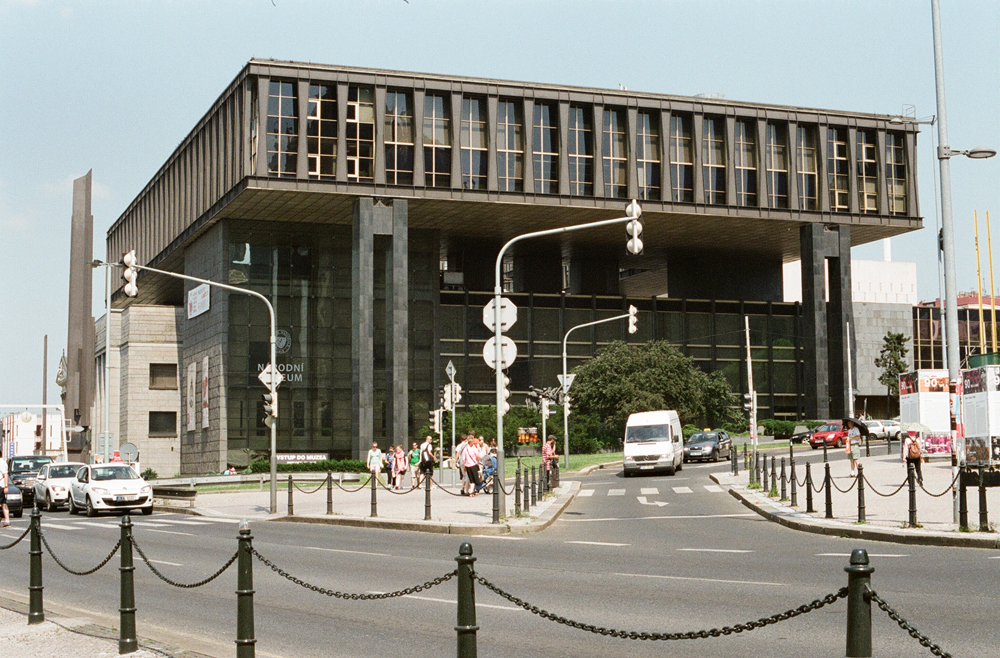 RS: Many similar polls have taken place recently – for instance the poll concerning the ugliest building in Prague. Readers were supposed to vote for the ugliest building out of ten propositions pre-selected by critics. In fact, nothing as tragic has happened in a long time as the poll only exacerbated the readers’ disorientation. Among the ten selected buildings, there was, for example, Don Giovanni, a hotel near the Želivského metro station that is objectively bad architecture, as well as quite interesting constructions such as Frank Gehry’s Dancing House. In the end, the Federal Assembly by Karel Prager was labeled the “ugliest building,” even though it presents excellent and cutting-edge architecture of the 1960s. The aim of architectural criticism is to present good examples to all people, not only to those involved in architecture.
RS: Many similar polls have taken place recently – for instance the poll concerning the ugliest building in Prague. Readers were supposed to vote for the ugliest building out of ten propositions pre-selected by critics. In fact, nothing as tragic has happened in a long time as the poll only exacerbated the readers’ disorientation. Among the ten selected buildings, there was, for example, Don Giovanni, a hotel near the Želivského metro station that is objectively bad architecture, as well as quite interesting constructions such as Frank Gehry’s Dancing House. In the end, the Federal Assembly by Karel Prager was labeled the “ugliest building,” even though it presents excellent and cutting-edge architecture of the 1960s. The aim of architectural criticism is to present good examples to all people, not only to those involved in architecture.
JB: Does the current Czech criticism present good examples?
RS: I am not really sure. In the 1990s, the situation was not too good, as many popular reviews (i.e., Our Home) were presenting quite bad examples. Around the year 2000, the situation changed and many interesting architectural works can be found even in popular reviews. Furthermore, a few regular newspaper rubrics on architecture were created (for example, Adam Gebrian’s rubric in Lidové noviny), and modernly designed houses appealing to popular taste exist, such as the simple kit homes of the Archteam atelier consisting of simple red constructions with gabled roofs. So the supply exists, but the demand stays doubtful.
JB: Does the problem consist of the lack of a clear definition of modern and contemporary architecture? Many new constructions, presented as cutting-edge architecture, seem to be rather eclectic and formalistic collages of old models. For instance, the recently proposed Flower House on Wenceslas Square is supposed to suggest “praying palms, the Saint Vitus Cathedral and a blooming flower.”
RS:On the one side, Prague is haunted by a desire to become a European metropolis and this desire should also be expressed in contemporary architecture. On the other side, there are also protectors of the Old Prague, among whom I count myself. The local debate does not analyze what actually is modern; it is rather a fight between traditionalists and modernists, a kind of trench warfare. For instance, the debate on the New National Library by Jan Kaplický had almost no value. I do mind if the debate becomes political. The National Library is a political issue par excellence. However, mainstream media soon restricted the debate to the two following positions: like and dislike. Everyone who dared to criticize the project was treated as a parochial person who must be convinced.
 JB: Popular media have been quoting your statement: “I will never leave the panelák.” The Czech panelák (a colloquial term for panel buildings) is an often negatively connoted prototype construction whose origins can be found in the avant-garde or the industrial production in Zlín. Could you explain its main assets and insufficiencies?
JB: Popular media have been quoting your statement: “I will never leave the panelák.” The Czech panelák (a colloquial term for panel buildings) is an often negatively connoted prototype construction whose origins can be found in the avant-garde or the industrial production in Zlín. Could you explain its main assets and insufficiencies?
RS: The attitude towards the panelák evolved dramatically. In the 1990s, almost everyone was criticizing these constructions – the stereotypes of a concrete jungle or rabbit hutches are well known – yet today, the general attitudes seem to be subtler. External insulation had its role in this process; polystyrene was put on walls and covered with latex colors. The main negative aspect of these renovations, however, is the vanishing materiality of architecture. Architecture was always linked to materiality; polystyrene cladding denies it.
Furthermore, many serious attempts to analyze the history of panel-building settlements emerged, such as the book by American critic Kimberly Elman Zarecor. Young Czech historians begin to study these issues and the Ministry of Culture has recently attributed an extensive grant-in-aid within this field. Panel-block housing settlements differ in quality. The main deficiency of this architecture is its poorness; there is only a minuscule amount of architecture. Order, regularity and geometry are, however, qualities inherent to almost every panelák. The urban assets of the panelák are considerable – one can recognize that architects designed it. Most of the panel-block housing settlements have a high-quality park finishing; if it is correctly maintained, one feels like one is living in a park. This asset compensates for the lacking feeling of a life in a compact city and the excessively open space without squares and corridor streets. Many predicted a gradual degradation and the emergence of slums within these settlements, yet these predictions seem to be erroneous.
JB: Aren’t the assets of the panelák also related to their social status? For instance while many French suburban areas were a result of a process of an inner colonization, paneláks at first embodied accessible housing for many members of the working classes.
RS: This is exactly what I hope to analyze in a grant because we completely lack the sociological comparison of Czechoslovak block-housing settlements with similar occidental constructions of the period. The thesis of Lucie Zadražilová, who is also responsible for the grant, is a pioneering project in this field.
JB: Are the deficiencies of panel-block housing related to a certain conception of power? In fact, the urbanism born in the twentieth century may be a kind of “biopower,” as Michel Foucault would call it. Problems related to paneláks don’t reside in their “communist character,” but in a certain conception of power that appears under different regimes.
RS: I don’t think that motives to create these settlements were deliberately related to biopower. The regime was not sophisticated enough to use such ingenious techniques of manipulating people. The main issue with the panel-block housing settlements was only the quantitative aspect of constructing as many apartments as possible. This created significant issues, as the quantity was so large that the quality of these settlements was often neglected. In the 1960s, many architects tried to propose interesting architectural solutions to these settlements, but this tendency almost disappeared during Husák’s regime. The demographic process of increasing numbers of city habitants began during the Industrial Revolution. Panel technology was one of the possible answers to this process.
JB: It is interesting that the origins of this technology were developed in the Ba?a shoe plant, representing a paradigmatic example of Czechoslovak Taylorism.
RS: Yes, the origins of this technology can definitely be found in American Taylorism that was concerned with the question of how to reach a given performance in the most economic manner. Even the American Taylorists studied how to build a brick house in the most efficient manner (i.e., the work on motion study by Frank Bunker Gilbreth, Sr.). By replacing bricks with panels, the entire construction could be completed faster. The origins of panel technology are rooted in American Taylorism; the panel technology must have appeared at a certain moment. It is the result of a modernization process, which has nothing in common with Socialism.
JB: Another heritage of the communist regime is the so-called Brussels Style, a local version of the International Style, which is currently an issue in many debates and faces a threat of destruction, such as the current debate on the demolition of the Havidov train station by Josef Hrejsemnou. What are the main features of the Czech Brussels Style that distinguish it from the International Style of that period?
 RS: The Brussels Style does not differ much from the International Style of that time; the only difference could be the startling concentration of talented artists. However, there is no specifically Czechoslovak form; it is rather a lucky synthesis of various impetuses. After 1948, architects could not visit Western countries; they knew Western buildings only from snapshots and they tried to imitate them in an improvised manner. One can recognize this in, for example, Karel Prager’s Institute of Macromolecular Chemistry, where the do-it-yourself aspect gives the Czechoslovak architecture a slightly different style. Although these aspects can be usually recognized only by experts on architecture, I am very happy that the architecture of 1950s, 1960s and 1970s generates interest among the current young generation. Exhibitions such as Brussels Dream (May 14 – September 21, 2008) or Kotvy Máje (March 2 – 19, 2011) have almost overshadowed the interest in interwar functionalism. This provokes a debate on the preservation of these buildings. Until 2000, around ten of these buildings have succeeded in obtaining the status of protected monuments from the Ministry of Culture. Since then, however, the ministry refuses to declare any building a monument in case of disapproval of its owner, regardless of the fact that the Monument Conservation Act enables one to declare a building a monument independently of its owner. Buildings such as the Havidov Train Station by Josef Hrejsemnou, the Ješt?d Commercial Center in Liberec by Karel Hubanek and Miroslav Masák, the Uran Commercial Center in Ceská Lípa by architect Emil P?ikryl, and the destruction of the interior of Thermal Hotel in Karlovy Vary and of Machonin’s oeuvre are only the most striking victims of these policies.
RS: The Brussels Style does not differ much from the International Style of that time; the only difference could be the startling concentration of talented artists. However, there is no specifically Czechoslovak form; it is rather a lucky synthesis of various impetuses. After 1948, architects could not visit Western countries; they knew Western buildings only from snapshots and they tried to imitate them in an improvised manner. One can recognize this in, for example, Karel Prager’s Institute of Macromolecular Chemistry, where the do-it-yourself aspect gives the Czechoslovak architecture a slightly different style. Although these aspects can be usually recognized only by experts on architecture, I am very happy that the architecture of 1950s, 1960s and 1970s generates interest among the current young generation. Exhibitions such as Brussels Dream (May 14 – September 21, 2008) or Kotvy Máje (March 2 – 19, 2011) have almost overshadowed the interest in interwar functionalism. This provokes a debate on the preservation of these buildings. Until 2000, around ten of these buildings have succeeded in obtaining the status of protected monuments from the Ministry of Culture. Since then, however, the ministry refuses to declare any building a monument in case of disapproval of its owner, regardless of the fact that the Monument Conservation Act enables one to declare a building a monument independently of its owner. Buildings such as the Havidov Train Station by Josef Hrejsemnou, the Ješt?d Commercial Center in Liberec by Karel Hubanek and Miroslav Masák, the Uran Commercial Center in Ceská Lípa by architect Emil P?ikryl, and the destruction of the interior of Thermal Hotel in Karlovy Vary and of Machonin’s oeuvre are only the most striking victims of these policies.
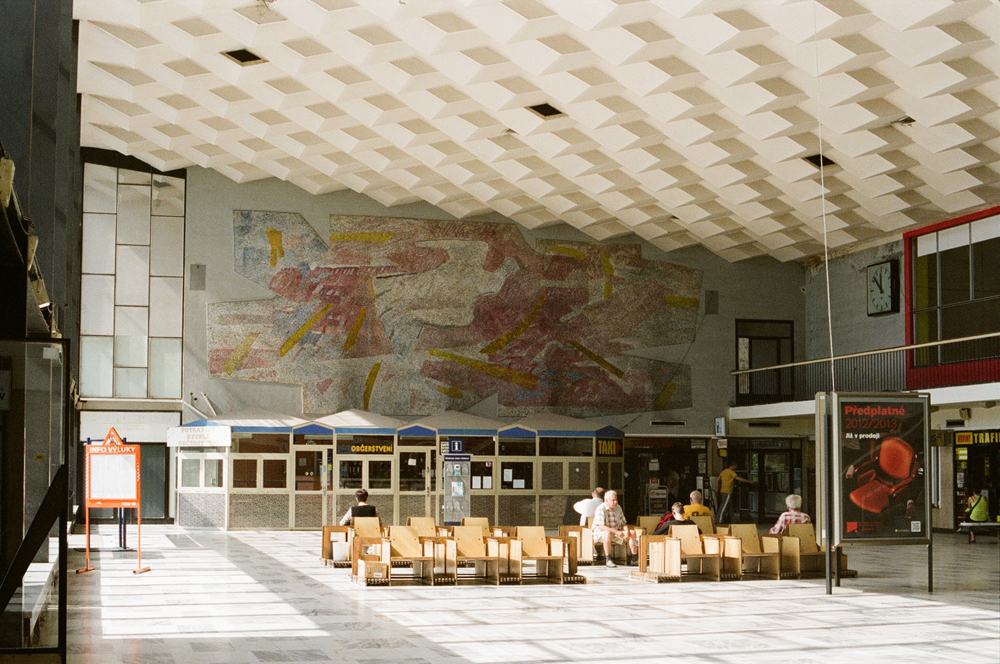 JB: Many buildings of this era lose their significance if their expressive interiors disappear. In Machonin’s Kotva Commercial Center, for instance, only the exterior surfaces have been preserved.
JB: Many buildings of this era lose their significance if their expressive interiors disappear. In Machonin’s Kotva Commercial Center, for instance, only the exterior surfaces have been preserved.
RS: This is simply luck; it could have ended much worse. I remember my trip to Berlin in the mid-1990s, during which I visited Machonin’s Czech Embassy. Even some of our German friends and the architect Ivan Reimann claimed it was the ugliest building in Berlin. Today, nobody would dare to utter such a statement; the attitude towards this architecture has changed considerably during the last fifteen years.
JB: Does the difference between the Brussels Style and the International Style consist in the use of high quality materials?
RS: No, the expensive materials were used only in the late 1960s. On the contrary, typical Brussels Style tried to experiment with new materials like plastic. An important feature of the Brussels Style is mainly its political significance; it was a sign of the political thaw of Kruschev’s government and of more democratic politics of the regime.
JB: Is this why this architecture seems to be so problematic for the current regime, which refuses the idea of a left-wing but democratic society and tries to interpret the pre-1989 period only as a homogenous totality?
RS: The old regime gave no chance to its citizens to be left-wing or right-wing oriented; it was very hard to find any social critique in the architecture of the 1960s. Compared to Western architecture, Czechoslovak architecture completely lacks social critique. The quality of the Brussels Style, however, does not fit the black and white schemes of the current right-wing parties.
JB:Is Czech contemporary architecture political? Is Teige’s idea of architecture as a catalyst of social transformation still valid or was it attenuated by postmodernism?
RS: Even Czechoslovak postmodernism had a certain political aspect; it expressed the desire to stay in contact with the West. Czech architects were instructed by the tragic engagement of the interwar avant-garde. The typical attitude of a contemporary Czech architect is, thus, apolitical. This does not mean, however, that political issues vanished. The interest in monument preservation, issues concerning public space or social housing – all these things arouse public interest but architects often pay no attention to them.
JB: How should we preserve modern architecture and create a link between the present and the past without falling into a complete musealization and the disappearance of a debate?
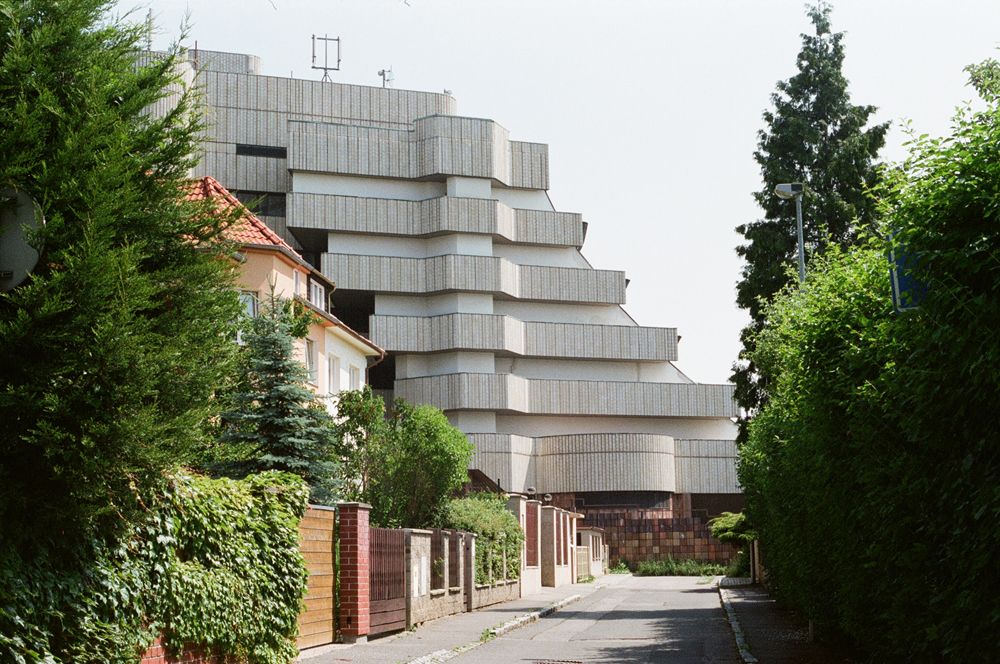 RS: As a member of the Club for Old Prague, I am becoming more and more involved in monument conservation. The common rule in the Czech Republic is that everything that is not preserved is condemned to destruction, which means that one is forced to protect as many monuments as possible. The conservation of monuments from the 1950s and 1960s is subject to current debate in the Czech Republic. Should ideology decide what to preserve? One of the eminent examples of such issues is the Hotel Praha in Dejvice built on the order of the Central Committee of the Czechoslovak Communist Party. The hotel certainly represents the former regime; however, many critics highlight the evident architectural qualities of this edifice and claim that ideology should not be taken into account. This reminds me of a statement by the architect Josef Pleskot, who asserted that a “monument must toil.” Even monuments must pay for their maintenance; we cannot create museums everywhere. So, the economical sustainability of monuments is also another important issue in this debate.
RS: As a member of the Club for Old Prague, I am becoming more and more involved in monument conservation. The common rule in the Czech Republic is that everything that is not preserved is condemned to destruction, which means that one is forced to protect as many monuments as possible. The conservation of monuments from the 1950s and 1960s is subject to current debate in the Czech Republic. Should ideology decide what to preserve? One of the eminent examples of such issues is the Hotel Praha in Dejvice built on the order of the Central Committee of the Czechoslovak Communist Party. The hotel certainly represents the former regime; however, many critics highlight the evident architectural qualities of this edifice and claim that ideology should not be taken into account. This reminds me of a statement by the architect Josef Pleskot, who asserted that a “monument must toil.” Even monuments must pay for their maintenance; we cannot create museums everywhere. So, the economical sustainability of monuments is also another important issue in this debate.
JB: The monument can either stay functional or have no function and, thus, become a museum. Is the polemics of Hotel Praha a case of the politicization of architecture related to the way in which every regime destroys monuments of the preceding regime?
RS: It has always happened in this way. What surprises me is the lack of selectivity of the socialist regime after 1948. For instance, the baroque was generally rejected as an unprogressive period of the Dark Ages after the Battle of White Mountain. The architecture of this era was, however, still preserved as a significant monument.
JB: Was pre-war functionalism preserved in the same manner after 1948?
RS: There were evidently some quandaries. First, functionalism was too recent to be considered a monument. But already in the 1960s, functionalist buildings began to be declared as monuments and in 1970, a conference called Conservation of Modern Architectural Monuments, held in Brno, and the subsequently published anthology constituted a significant contribution to the debate in this field. Czechoslovakia was very progressive at that time; it was one of the first countries to acknowledge the value of functionalist monuments. Since then, we have fallen asleep and the debate has not advanced.
JB: How did the political transformations of 1989 influence architecture? Were there any significant formal changes in architecture?
RS: The emergence of a private clientele is a factor from which we can infer many significant changes in the architectural field. Until 1989, the state was the only customer, whose taste corresponded to late modernism and was not really influenced by postmodernism. This state style norm disintegrated in 1989 and engendered a considerable variety of styles. Czech architecture has always been very receptive; there are a very small amount of proclaimed, essentially Czech forms. It is rather a reaction to the Western impetus that has accelerated. Czech architects have always seemed to be more sensitive to minimalism and austerity (particularly Swiss Minimalism) rather than towards more buoyant styles. It may be related to Teige’s claim that the extravagant is usually asocial.
However, no new revolutionary architectural style has emerged in the past few years. Only a renewed interest in urbanism appeared (see Pavel Hnili?ka’s book Urban Sprawl). Czech architecture is mainly concerned with family houses and small buildings, and almost no new interesting public buildings have been created. The only exceptions are some libraries, usually financed by a European Union grant. Unfortunately, Czech politicians lack interest in architecture, as it is not considered to be advocating their politics.
Prague, June 2013.

 Jana Beránková is a writer, freelance journalist and graduate student at École Normale Supérieure in Paris and at École des Hautes Etudes en Sciences Sociales. Her fields of study are the theory of architecture, photography, poetry and contemporary art. She writes for the literary review Host and the cultural bi-weekly A2. She is currently working on a book of essays concerning architecture of the industrial city Zlín in the Czech Republic and carries out research on Karel Teige and the relationship between poetry and Czech constructivism. She published a book of short stories in the Czech Republic.
Jana Beránková is a writer, freelance journalist and graduate student at École Normale Supérieure in Paris and at École des Hautes Etudes en Sciences Sociales. Her fields of study are the theory of architecture, photography, poetry and contemporary art. She writes for the literary review Host and the cultural bi-weekly A2. She is currently working on a book of essays concerning architecture of the industrial city Zlín in the Czech Republic and carries out research on Karel Teige and the relationship between poetry and Czech constructivism. She published a book of short stories in the Czech Republic.


